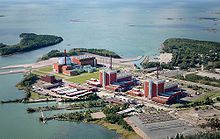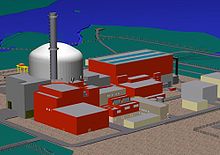European pressurized reactor
EPR is an acronym for a type of nuclear reactor. The EPR is a third generation pressurized water reactor design with a power of 1600 MW. It has been designed and developed primarily by Framatome (now Areva NP), Electricité de France (EDF) in France, and Siemens AG in Germany. Its name comes from European Pressurized Reactor (Pressurized European Reactor), although for a season it received the name of Evolutionary Power Reactor (Evolved Power Reactor). Currently the construction company, Areva, prefers to call it simply EPR and in the United States it is called US-EPR.
In 2020, EDF has been building an EPR reactor in Flamanville (France) for years while Areva SA is building another in Finland, but both are behind schedule.
History
The fall in oil prices in the 1980s and the Chernobyl disaster led to the slowdown, even abandonment, of nuclear programs in several countries, putting the nuclear industry at risk. Then he turned to export, a market where fierce competition invites the consolidation of the European industry. In this context, the French Framatome and the German KWU (future Siemens subsidiary) merged at the beginning of 1986. On April 13, 1989, a cooperation agreement was signed between Framatome and Siemens and a joint company was created: Nuclear Power International (NPI). This merger, supported by the respective States through the partnership of the French Nuclear Safety Authority and the German Federal Ministry of the Environment, was aimed at developing and commercializing a unique pressurized water nuclear reactor technology as a priority for the needs of the two countries, and then of all the world's electricity producers involved in nuclear power.
In 1990, Électricité de France (EDF) and nine German electricity producers began to combine their future programs, "Y2K REP" and Planungsauftrag, respectively. On January 14, 1992, they joined forces with NPI to launch the European Pressurized Reactor (EPR) project, a third-generation reactor intended to revamp the two countries' nuclear power plants. On February 23, 1995, engineering studies for the EPR began. EDF, which then completes the construction of the N4 level nuclear reactors, integrates into the Franco-German project its next level under study, called N4 +. German electricians did the same for their Konvoï B reactor. The detailed blueprint was proposed in October 1997 to the French and German safety authorities.
In 1999, the nuclear activities of Framatome and Siemens were merged into a new company called Framatome ANP (ANP for Advanced Nuclear Power), and the EPR project continued under the leadership of Dominique Vignon. Framatome (ex-Areva NP) presents the EPR as "generation III +" 3. EPR stands for Evolutionary Power Reactor. Renamed US-EPR in the United States and CEPR (Chinese EPR) in China.
Design
The primary design goals of the third-generation EPR are to increase safety while providing greater economic competitiveness through improvements to previous pressurized water reactor designs and increasing power generation capacity to about 1,650 MWe (net) with a thermal power of 4,500 MWt. The reactor can use 5% enriched uranium oxide, reprocessed uranium and 100% mixed uranium plutonium oxide as fuel. The EPR design is the evolutionary descendant of the N4 reactors from Framatome and KONVOI from Siemens Power Generation Division.
The RPE design has several active and passive protection measures to prevent accidents:
- Four emergency cooling systems, which provide the refrigeration required to cool the heat generated by the decay and which continues between 1 to 3 years after the initial shutdown of the reactor (300% redundancy).
- Container to leak tests around the reactor.
- A container and extra cooling area if a melted core manages to escape from the reactor (see containment building).
- A two-layer concrete wall with a total thickness of 2.6 meters, designed to resist the impact of an airplane and internal overpressure.
The EPR has a design maximum core damage frequency of 6.1 × 10−7 per plant per year.
Nuclear power plants
Okiluoto (Finland)
Okiluoto-3 in Finland, whose construction began in May 2005. According to the schedule provided by the Areva-Siemens Consortium in December 2019, nuclear fuel loading would take place in June 2020, and production of regular electricity in March 2021.
Flamanville (France)
Flamanville-3 in Normandy (France) began construction in December 2007. In 2019, Électricité de France (EDF) announced a €1.5 billion increase in the cost of building the EPR, a project that accumulates delays and setbacks. In this way, the final invoice for the reactor increased from 10.9 billion euros —already three times the initial estimate— to 12.4 billion euros. The electric company targeted a fuel shipment by the end of 2022, which is equivalent to a delay of ten years in the originally planned schedule.
France has 58 nuclear reactors, but around three-quarters of the park will reach the end of their useful lives by 2027. The government had hoped to decide to build EPR reactors to replace aging reactors, but delays have complicated the process. plan.
Taishan (China)
Taishan-1&2, in China. The Taishan 2 EPR nuclear reactor, located in southern China, started operating in 2019. EDF has a 30% stake in the joint venture responsible for building and operating both reactors. Chinese groups CGN and Yuedian own 51% and 19%, respectively.
Other proposed plants
- India: has ordered EDF 6 reactors at different locations.
- UK: Areva intends to build 6 reactors but there is no contract yet.


